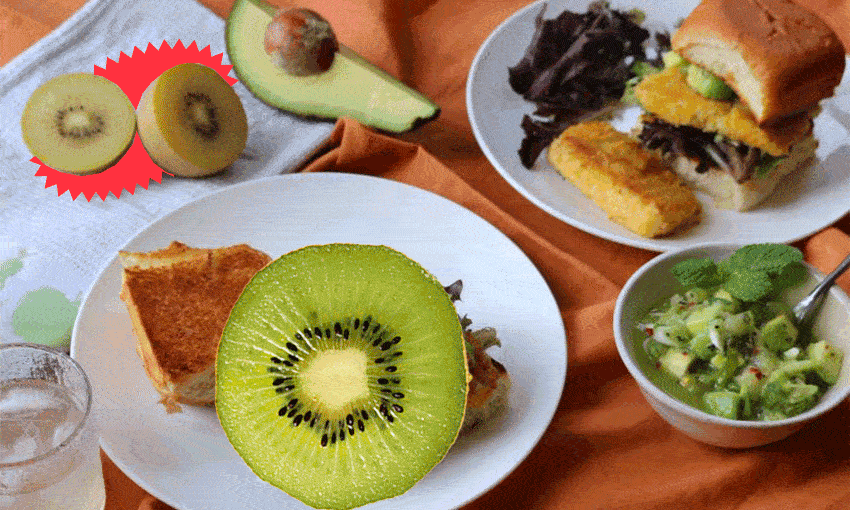The kiwifruit – which, awkwardly, has nothing to do with New Zealand and everything to do with a bunch of 1950s ad men pandering to a prejudiced market – has possibilities that extend way, way beyond the pav.
You may be thinking, “Kiwifruit, an ingredient? I just slurp mine from a teaspoon.” Or, if you’re a wild child with a steel spine and a taste for fuzz between your teeth, maybe you eat yours whole. Well hold your horses, we’ll get to the “kiwifruit in a meal” part. First, a brief history of Aotearoa’s tumultuous love affair with the kiwifruit.
A scandalous history
It’s important to note that the kiwifruit is not actually Kiwi. It’s a Chinese native that only saw Aotearoa’s shores for the first time in 1904.
But “Kiwifruit = Kiwi” is in full bloom in our shared psyche. I remember being at primary school in the early 2000s and participating in a school-wide Kiwiana artwork competition. Of the three winning artworks, two featured kiwifruit. (One showed a kiwi bird cut in half, revealing a kiwifruit interior – honestly, brilliant.)
So why does this furry fruit feel like a part of our national identity? The misleading – if deeply effective – renaming of the fruit was the work of a marketing campaign. When New Zealand began exporting kiwifruit to the US in the 1950s, the fruit was known as the Chinese gooseberry, which made Americans very uncomfortable during the height of the Cold War. Next came the moniker “melonette” – weird, because I can barely think of a fruit that tastes less like a melon – and also unpopular, because melons had high import tariffs.
It wasn’t until 1959 that the name kiwifruit was suggested by Jack Turner of Turners and Growers, and it wasn’t the official commercial name until 1974. It’s only taken a few short decades for the kiwifruit to wheedle its way into our hearts and minds.
Before you get too distraught, know that many varieties of kiwifruit were indeed born and bred in Aotearoa – local company Zespri has invested millions into developing new varieties of kiwifruit, including the Sungold golden kiwifruit. Developed after the disease PSA destroyed other kiwifruit strains in 2010, Sungold rejuvenated the country’s biggest fresh fruit export.
Unfortunately for Zespri, that’s not the end of the story. Sungold was then smuggled into China, resulting in lawsuits, millions paid in damages, the loss of intellectual property, and ongoing illegal cultivation in China that now outstrips New Zealand production.
So there you go. Your fruit history lesson for the day, done and dusted. Now onto the eating part.
Where to find it
At time of writing, the green “hairy” kiwifruit are $5.99 per kg at both Countdown and New World (about $0.90 each), and $4.99 at Pak’nSave.
Their sleek golden cousins are going for an eye-watering $10.99 per kg at New World and Countdown (about $1.65 each), and $8.49 per kg at Pak’nSave. Pak’nSave also has more affordable multipacks if you’re going ham on kiwifruit this weekend, but even so, you’re really paying for your vitamin C dose this season.
Other varieties, like the lovely red kiwifruit, can be found at Asian grocery stores on occasion. There’s also the sweet little kiwi berry, like the one-bite babies of kiwifruit parents, which should appear on our shelves in early February.
How to make it terrible
Some would answer this question by screwing up their faces and saying, “eat the fuzzy skin”, but that’s really a matter of preference. Some people love a sour, furry, gritty bite, and who am I to deny them that peculiar joy?
The more relevant question here is, what other foods does kiwifruit make terrible?
Kiwifruit contains a little beasty called actinidin, an enzyme that digests proteins found in gelatin and milk. Add raw kiwifruit to a delicious panna cotta, and you’ll have a dessert that never sets. Similarly, milk added to a kiwifruit smoothie will curdle and split before too long, so drink it quick – or make your kiwifruit smoothie dairy-free.
Actinidin is also an allergen for some people, causing an itchy throat, wheezing, and occasionally life-threatening anaphylaxis, making the seemingly innocent kiwifruit the peanut of the fruit world. Basically, it’s not the best fruit to sneak into a potluck situation.
How to make it amazing
Kiwifruit is perfect as a solo snack, added to a summery fruit salad, layered over a coconut rice pudding, blitzed into a (dairy-free) green smoothie or used as a pavlova topping.
But if you want to get creative, kiwifruit also makes an excellent base for a tangy hot sauce, chutney or salsa. My current favourite is this kiwifruit, avocado and mint salsa to top off crunchy Panko crumbed fish burgers (see opening image). It tastes light, fresh and summery, and the salsa uses both golden and green kiwifruit, so no one’s being left out.
Green kiwifruit can also be used to tenderise meat by naturally breaking down protein and connective tissues (the “pro” element of the enzyme actinidin), making your beef, lamb or chicken soft and tender – without picking up a mallet.
To get the job done, either de-flesh a green kiwifruit and rub the inside of the skin over the meat, or mash up the flesh with a pinch of salt and a drizzle of olive oil, and coat the meat in the puree. Marinate for 15 minutes, and wipe it away before cooking.
Best of all, when your dinner guests swoon, “Ooh, how did you make your lamb so tender?” you can raise an eyebrow and say, “Simple – I used the enzymatic tenderisation process.”
Wyoming Paul is the co-founder of Grossr, a meal kit alternative through your supermarket.





